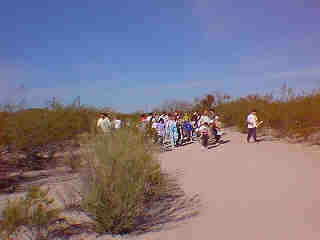
 |
At Sabino Canyon that day, we had a good size group of mixed age homeschoolers, from kindergarteners through high schoolers. After half a day, the younger kids departed and the older kids went on into the canyon for the rest of the day and more detailed discussions. Our guide gave a fascinating talk, with much of what he knows not being in books, but learned directly from the Apaches and survival experience. He had us all on the tips of our shoes anxious to hear! At one point I commented that he ought to put all this wealth in a book, and he replied that he was indeed working on one. So watch the shelves, everyone, for Jon Helleson! |
| First we came to the Chaperal bush, or more commonly known around here as the Creosote. It gives off a very strong sweetish smell when wet, which is very pervasive all over town whenever it rains. The flowers are edible, and the tea of its dried leaves are used as an all purpose remedy for everything from flu to athlete's foot. It exudes a growth inhibitor into the soil around it, to keep other plants from growing near it and competing for moisture. We were to meet this bush again on the Tohono Chul Park field trip. | 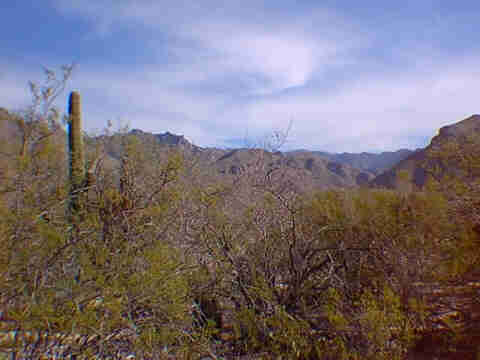 |
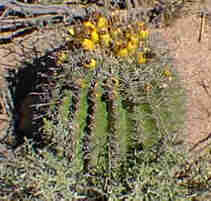 |
Next we came to the Barrel cactus, with its yellow fruit resembling tiny pineapples. The fruit may be eaten by removing the seeds and eating them, discarding the outside. The inside of the cactus itself is edible as well in a survival situation, if attacked with a machete, but it will make you feel cold, and too much of it will cause one to throw up. This cactus is very useful as a snake bite remedy, if you use the bottom two thirds of it, and apply the pulp to the wound. Jon told a story of a man whose leg was saved even long after a rattlesnake bite, when the doctors had run out of solutions and were beginning to talk about amputation. To prepare Barrel cactus pulp in advance, so you can carry it with you in the desert, put it in a jar in the refrigerator. After 4 days it will begin foaming. After 4 more days, it will be fermented enough that you can take it out of the refrigerator and store it on the shelf indefinitely. When you go into the desert you can carry the jar with you. Last but not least, the thorns of this cactus can be played like an African thumb piano! (But you gotta sit in the desert to play it.) |
| Next we came to a Saguaro, a Mesquite tree, and mistletoe living in an interdependency. Baby Saguaro cactus require shade from the intense sun in their early years, and generally find it in the shade of a Mesquite tree. As it grows up, it eventually kills the Mesquite tree by simply crowding it out. The Mesquite tree is also host to misteltoe, the red growth in the picture, which is poisonous to humans, but birds like the berries. The Mesquite draws the birds, who eat the berries, and drop the seeds elsewhere for misteltoe propogation. The seed pods of the Mesquite are edible. The pod is ground into a fine powder, and the bulky tough seeds discarded. The powder is excedingly sweet. Jon passed around a small baggie for everyone to dip their finger in and taste (I'm sure it looked like a scene out of Woodstock) and it was, I'd say, as sweet as nutrisweet. The Saguaro fruit are edible too. They are harvested by knocking them off the top of the cactus with a long Saguaro rib, leftover from another dead Saguaro. The local Tohono O'Odham native Americans process Saguaro fruit into jelly every year. The Saguaro also has medicinal properties, but Jon said he was not allowed to tell us about them, because the Saguaro is a protected plant. |
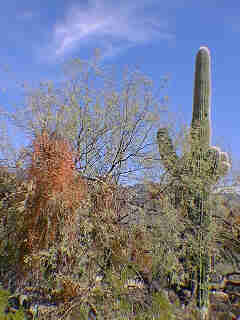 |
 |
The Prickly Pear has a wealth of uses. Most types are edible, particularly when they have chomp marks on them from javelina (wild desert boars). However, stay away unripe fruit and the type of Prickly Pear with orange crossed thorns -- they're poisonous. Generally, though, the pads, flowers, and ripe fruit are all edible. The sliced inner pads are used to treat sunburn and are 5 times more effective than Aloe Vera. They may also be used to remove thorns that have been inflicted by cactus, or even the Prickly Pear itself! Apply the peeled sliced pad to the area, wait a while, and when the pad is removed, it will take the thorns out with it. One should be aware of the uses of Prickly Pear and other cactus for survival, in case of being stranded in the desert, since almost every year in the news somebody dies that way. The slimey cactus pulp can be smeared on the body and in the mouth to prevent water loss through evaporation. The pulp itself provides some consumable moisture, hopefully enough to preserve your life until you can be rescued. |
 |
Toward the end of the morning's talk, we came to mustard, which grows wild all over Tucson. The young tops and flowers are excellent raw, but can be cooked if they taste too strong. The seeds can be used as a spice. Medicinally, it aids digestion, and possible other uses are being researched. |
| And now we come to my favorite of the day! This is Malva Neglecta, a highly nutritious green leafy vegetable that grows as a weed all over Tucson! It is very high in calcium, has a mild lettacey taste, and is in fact so good for you, there are people trying to teach the homeless of Tucson to eat it because it's everywhere. When Theresa and I got home from the field trip, we found it growing in our, ahem, garden, and it made a lovely addition to our salad and soup that day. The seeds and leaves are edible, and the roots can be used as an egg substitute in baking. I can only guess that it hasn't been commercialized because it wilts so quickly after picking. You have to eat it fresh! |
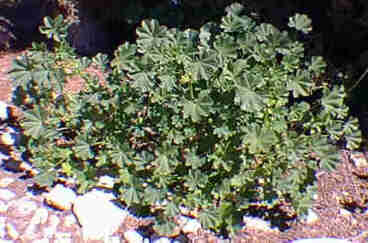  |


